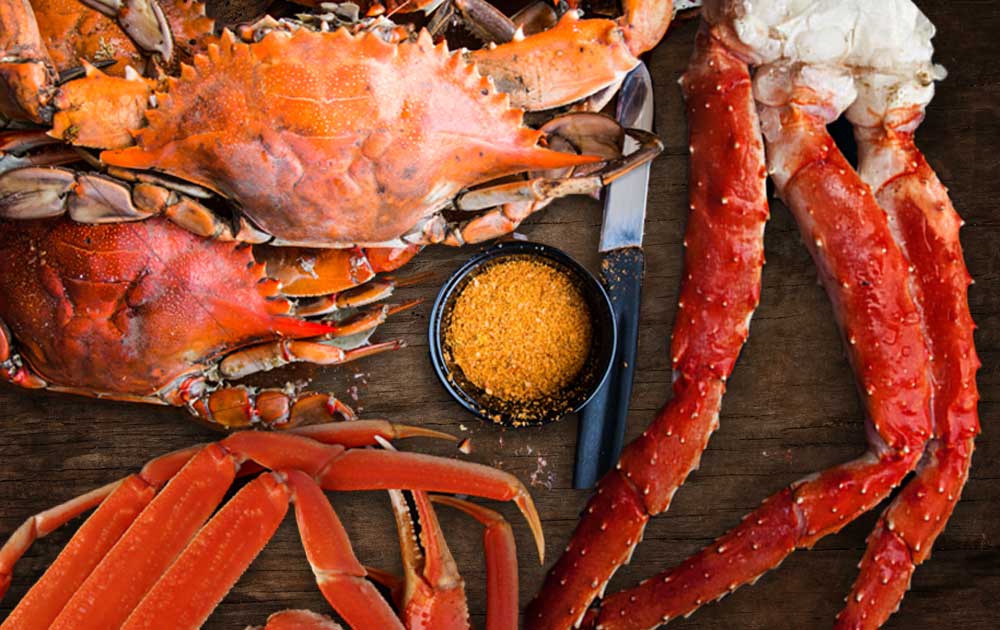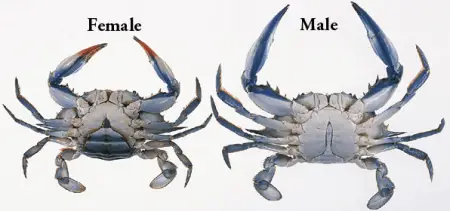

Males mate several times in a lifetime, while females mate only once. In terms of molting, male blue crabs shed their shell about twenty times until maturity, while female blue crabs shed about eighteen times. Males also have broader bodies and more pronounced spines than females. The apron of male blue crabs has the shape of the Washington Monument because it is long and pointy, while the apron of the female blue crabs has the shape of the United States Capitol because it is round. Male blue crabs have bright blue claws, whereas female blue crabs have red-tipped claws (often likened to the red painted nails of female humans). What, then, is the difference between male and female blue crabs? It is also believed that female crabs have dense meat. In areas where catching female crabs is allowed, females are eaten not only for their delicious meat but also for their roe (eggs). The open flap is used to mate and to carry her eggs. Upon reaching maturity, a female blue crab’s flap opens. Adolescent female blue crabs, or “sally,” have triangle-shaped flaps and are also called “v-bottoms” in some areas.Ī female blue crab sheds its shell about eighteen times until it becomes an adult. As a mnemonic, people often say it has the shape of the United States Capitol. If flipped upside down, you will also notice that a female blue crab has a rounded or inverted U-shaped apron. To easily remember this, people liken these red tips to the “red nails” of female human beings.ĭifference between a Bobcat and a Mountain Lion Finally, males are believed to have flaky meat.Ī female blue crab, or “sook,” has red-tipped claws. A male blue crab “molts” or sheds its exoskeleton about twenty times before reaching adulthood. An adult male blue crab may mate many times in its lifetime.
Blue crab male vs female free#
However, you will notice that an adolescent male blue crab’s apron is shut, whereas an adult male blue crab’s apron is free to open, a sign of its readiness to mate. It is difficult to determine the sexual adulthood of the male blue crabs. It is also observed that a male has a distinct broad shape and very pronounced spines. A male blue crab’s apron is long and has a pointed tip, which is often facetiously called the “Washington Monument” by watermen.

Aside from its claws, a male blue crab can also be identified by the shape of its “apron,” which is the flap on its bottom. Fresh blue-crab meat should have a mild aroma pasteurized should have a slight, “heated” aroma.Male Blue Crabs Female Blue Crabs Claws are bright blue Claws are red-tipped Apron is long and pointy (similar to the shape of the Washington Monument) Apron looks like an inverted U (similar to the shape of the United States Capitol) Broader body more pronounced spines Slightly narrow body than males spines are not as accentuated Molt twenty times until maturity Molt eighteen times until maturity Mate many times in a lifetime Mate only once in a lifetime Meat is flaky Meat is dense famous for the roe Also called “jimmy” Adult females are also called “sooks” while adolescent females are also called “sally” DescriptionsĪ male blue crab, also called “jimmy” by boatmen, can be identified by its bright blue “chelipeds” or claws. Pasteurized meat is firmer and darker than fresh crab meat. Claw meat has a brownish tint, which is natural. Cooked shells of blue crabs turn orange-red. Softshells offer a crunchy texture, since they are eaten shell and all. The body meat is delicately flavored, while claw meat is nutty. Meat of the blue crab has a rich, sweet, succulent and buttery flavor. The same species is found in Central and South America, which supply crabmeat to the U.S. North Carolina and Louisiana have blue-crab fisheries as well. The largest concentration is in Chesapeake and Delaware bays off Maryland and Virginia. Blue crabs are found in brackish estuaries and bays from Cape Cod to the Gulf of Mexico. The crabs are harvested with traps, nets and dredges. Peeler crabs are those taken just before molting softshell crabs are those harvested right afterward. Blue crab is sold in both hardshell and softshell forms. There are no size limits on mature female crabs (“sooks”). In the domestic fishery, male crabs (“Jimmies”) and immature females (“Sallies”) may be taken as hardshells when their carapace measures 5 inches.

Males have blue claws females’ claws are orange-tipped. Blue tinges on dark shells and blue patches on the legs give the crab its name.


 0 kommentar(er)
0 kommentar(er)
